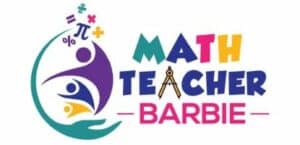
When would you use an area model? What does it represent? An area model can be useful any time we are multiplying in either arithmetic or algebra. However, it is not always the most efficient method, as I will explain below.
An area model is a visual way of organizing multiplication problems with multiple digits (number arithmetic) or terms (algebra). Area models represent multiplication geometrically as the area of a rectangle.
Setting up multiplication problems using area models helps us ensure that we multiply fully without duplicating or omitting any parts of the multiplication. Read on to find out more about when an area model is useful. To learn how to set up and use the area model, check out my blog post Setting Up and Drawing an Area Model, or do a deeper dive into the area model at the Math Teacher Barbie YouTube Area Model playlist.
Area definition of multiplication
For the past several decades, we often learned multiplication as repeated addition. However, this is not the only interpretation, or even definition, of multiplication. Children today are being introduced to several of these definitions of multiplication, with the hopes of giving them a deep understanding and a wealth of tools to use when multiplying. If you look closely, each of the views of multiplication is a variation on the others; they are essentially different views of the same phenomenon. (Think about how you might have a different perspective on something than someone else does. These definitions of multiplication are like that. They are each a way of seeing the same idea happening, just from a different perspective.) Some of the ideas of multiplication your child’s teachers will present include:
- Repeated addition (often built from skip-counting)
- Identical groups (see my post on grouping and regrouping for more on this, specifically this paragraph)
- Area of a rectangle — This is where the Area Model comes in.
Many of us learned the area of a rectangle as an application of multiplication, but historically geometric interpretations were the norm rather than the afterthought, as this World History Encyclopedia about Ancient Greek Mathematics demonstrates. Mathematics was first articulated as a means to understand the world. Its sophistication and deeper exploration grew along with astronomy and other sciences based in the physical, or geometric, world. Thus, area might even be considered a basic interpretation, or definition, of multiplication, not just an application.
This interpretation of multiplication has further benefits when we extend to the third dimension with volume, and helps modern mathematicians as they explore the possibilities and characteristics inherent in fourth, fifth, or even more dimensions.
Relationship between Area Model and Arrays
If you’re not familiar with what an array is, check out this post. An array is one of the earliest models used to bridge children’s understanding from skip counting and addition to multiplication. To do this, most of the arrays children encounter in school are rectangular with each row containing the same number of items, and each column also containing the same number of items. Picture putting the array items on a grid where each square represents one square unit. Then we can measure the area of the grid the array covers by multiplying the two sides of the array.
When are other tools easier?
For single-digit multiplication, memorization of facts, or fact look-up, is more efficient than the area model. In fact, knowing these single-digit facts is an essential part of successfully using the area model.
When multiplication goes beyond a certain number of digits (probably around four digits by three digits or so), the traditional algorithm (see this video comparing the two) can be more efficient (when one does not have a calculator handy, anyway). This efficiency is likely why the traditional algorithm was the focus of arithmetic instruction for so long. However, these days that we carry calculators around in our pockets (in the form of smartphone apps), understanding the multiplication is much more important than efficiently computing by hand. If your child has not yet been introduced to the traditional algorithm, they will learn it in the next few years. In the meantime, focus on the models that are known to build a depth of understanding, even when they are less efficient.
Let me know what else you’d like to know about the area model, or any other math your child is learning, at this google form. And remember,
You’ve Got This!
